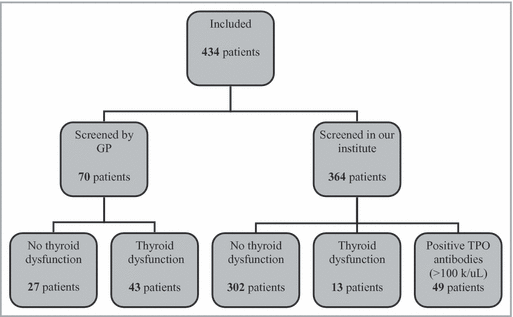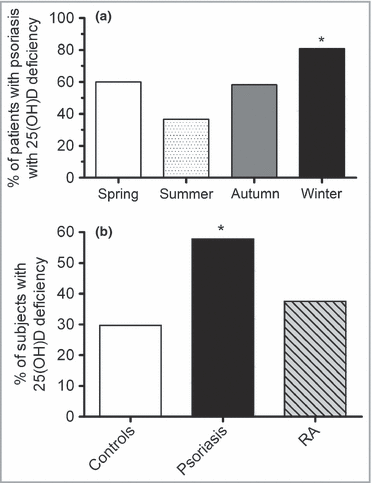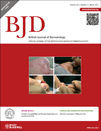Editor’s Choice March 2012
Thyroid screening in nonsegmental vitiligo

Kroon et al. report that the overall prevalence of thyroid dysfunction in adult patients with nonsegmental vitiligo is higher than in the general population. Most cases of overt thyroid dysfunction were in symptomatic patients already diagnosed by their general practitioner. In the majority of the patients the thyroid involvement preceded the onset of vitiligo. Routine screening of nonsymptomatic patients with vitiligo yielded overt thyroid disease in 0·8% and subclinical disease in 2·7% of the cases. A high titre of thyroid peroxidase antibodies with a risk of 53% for developing clinical disease was found in 8·8%. Thyroid disease was found mostly among older women and in subjects with a positive family history for thyroid disease. Thyroid screening in symptomless patients with vitiligo could be restricted to these high-risk subpopulations.
Kroon MW, Joore ICKW, Wind BS et al. Low yield of routine screening for thyroid dysfunction in asymptomatic patients with vitiligo. Br J Dermatol 2012; 166: 532–38.
SJS and TEN with lupus erythematosus

The incidence of lupus erythematosus (LE) among patients with Stevens–Johnson syndrome/toxic epidermal necrolysis (SJS/TEN) is considerably higher than in the general population. Most patients with suspected SJS/TEN with concomitant LE have clinical and/or histopathological properties allowing differentiation. A combination of recent LE exacerbation, evident photodistribution, annular lesions and absent or only mild focal erosive mucosal involvement may favour the diagnosis of LE. Histopathologically, junctional vacuolar alteration and the presence of solitary necrotic keratinocytes at lower epidermal levels, combined with moderate to dense periadnexal and perivascular lymphocytic infiltrates with a variable presence of melanophages and mucin, point to an LE-related origin.
Ziemer M, Kardaun SH, Liss Y, Mockenhaupt M. Stevens–Johnson syndrome and toxic epidermal necrolysis in patients with lupus erythematosus: a descriptive study of 17 cases from a national registry and review of the literature. Br J Dermatol 2012; 166: 575–600.
Vitamin D status in psoriasis

Gisondi et al. conducted a cross-sectional study over 1 year including 145 patients with chronic plaque psoriasis, 112 patients with rheumatoid arthritis (RA) and 141 healthy controls. The prevalence of vitamin D deficiency in patients with psoriasis was 57·8% vs. 37·5% in patients with RA and 29·7% in healthy controls (P < 0·001). In winter, the prevalence of vitamin D deficiency rose to 80·9% in patients with psoriasis, to 41·3% in those with RA and to 30·3% in healthy controls (P < 0·001). Vitamin D deficiency was associated with psoriasis independent of age, gender, body mass index, calcium, parathyroid hormone levels and season of blood sampling.
Gisondi P, Rossini M, Di Cesare A et al. Vitamin D status in patients with chronic plaque psoriasis. Br J Dermatol 2012; 166: 505–10.
Skin physiology adaptation in infants
Fluhr et al. studied the molecular composition of the stratum corneum (SC) and the water profile in 108 subjects divided into six age groups ranging from full-term newborns (1–15 days) to adults aged 20–35 years. They showed that skin acidification is still under development during the first weeks of life. While the basal epidermal barrier is competent immediately after birth, the SC is less hydrated in the first 2 weeks of postnatal life. Similar continuous decreasing water content towards the surface for all age groups was observed, although this gradient was lower for the newborns. Dynamic changes in the amounts of the natural moisturizing factor constituents were revealed in the period of infancy.
Fluhr JW, Darlenski R, Lachmann N et al. Infant epidermal skin physiology: adaptation after birth. Br J Dermatol 2012; 166: 483–90.




